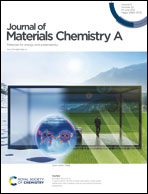Operando systems chemistry reaction catalysis (OSCR-Cat) for visible light driven CO2 conversion†
Abstract
A systems chemistry approach is taken for compartmentalization of a continuous reaction medium (water and CO2) with induced creation of micro-heterogeneity in the medium by using a SOM (soft-oxometalate) catalyst. The first step involves compartmentalization of an assembled catalyst-photosensitizer duo catalysing the reduction of CO2 into formic acid in two reaction spaces: the interior of the compartment and the exterior of the compartment. The exterior compartment obeys typical surface activity driven nanocatalysis principles where the perturbation of the catalyst surface area inversely varies with product yield. The second step of disassembly to disrupt the SOM-catalyst, induced by addition of a base, releases the interior reaction product with total disappearance of the catalyst system. The assembly–disassembly cascade demonstrates the application of systems chemistry principles in perturbation, compartmentalization, catalysis and release of products with well-defined externally controlled stimuli such as concentration, light, and pH. The OSCR-catalyst reported here is an attempt to emulate Golgi bodies in the context of cellular chemistry on a functional level.



 Please wait while we load your content...
Please wait while we load your content...